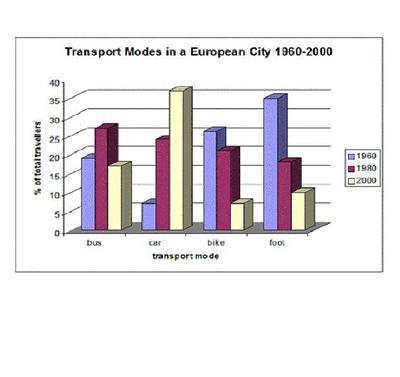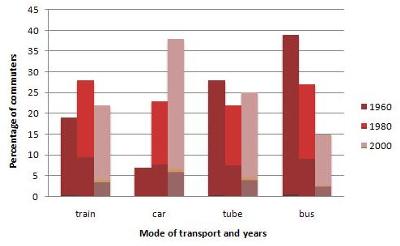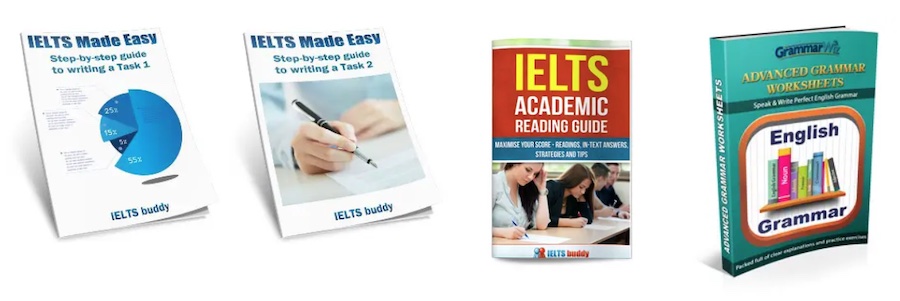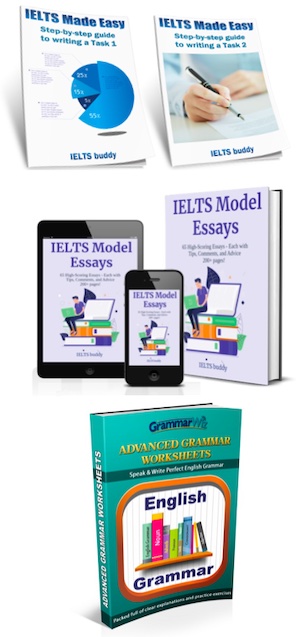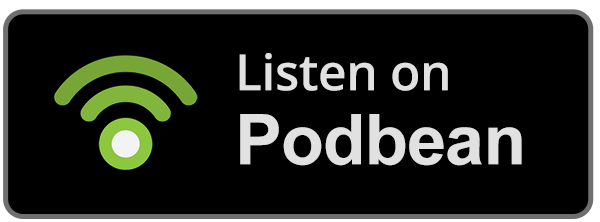IELTS Bar Chart - Transport used to travel in a European City
by Kazi Afzal Hossain

The bar chart shows the different modes of transport used to travel to and from work in one European city in 1960, 1980 and 2000.
The bar chart illustrates the different types of transports used to travel in a European City from 1960 to 2000. It is evident from the chart that, car transport was gradually increasing throughout the period, while the other transports were declined.
To begin, car traveler stood at just 5 per cent in 1960, which was 5 times less than for the bike traveler, and this was far less than on foot. Apart from a jump to approximately 35% of total travelers in 2000.
The next two transports popularity were the similar trend, both were gradually decreasing over the time frame. In 1980, bike and foot travelers were 20% and at about 18% respectively. At the end of the period, both transports were in between 5 to 8% in 2000.
Bus popularity spiked to 25 per cent in 1980. Then its popularity decreased the following year, and the bus traveler was 15 per cent.
Please give me feedback on my graph
Task 1 Bar Graph Over Time:Modes of Transport
by DRAVID
(THAILAND )

The graph shows the different modes of transport used to travel to and from work in one European city in 1960, 1980 and 2000.
The bar graph changes in the transports used to and from work in a particular European city for three years.
Overall the chart indicates that car used increased over the period shown, where as use of bus declined. The figures for tubes and trains both fluctuated over the same period of time.
As regard, by far the greatest proportion of commuters used bus, at nearly 40%. The figures for other means of transports- tube, car and train- were at around 27%, 22% and 19% respectively.
Between 1960 and 2000, commuters using bus fell in popularity as the figure fell to about 26% in 1980 and this fell even further to 15% in 2000. In contrast, use of car increased significantly to about 23% in 1980, before pushing the figure to well above 35% towards the end of the period. To move to train, the figures increased to about 26%, but this fell to just over 20% by 2000. Use of tube declined in 1980, in terms of tube, there was marked downward trend in 1980, before rising to a quarter in the final year.
==================================================
IELTS buddy
Feedback
Corrected Version:
The bar graph illustrates changes in the transport used to and from work in a particular European city for three years.
Overall the chart indicates that car used use increased over the period shown, where as whereas the use of the bus declined. The figures for tubes and trains both fluctuated over the same period of time.
As regard, Regarding 1960, by far the greatest proportion of commuters used buses, at nearly 40%. The figures for other means of transport- tube, car and train- were at around approximately 27%, 22% and 19% respectively.
Between 1960 and 2000, commuters using bus fell in popularity as the figure fell the popularity of the bus with commuters fell to about 26% in 1980 and this fell even further to 15% in 2000. In contrast, the use of cars increased significantly to about 23% in 1980, before pushing the figure rising steeply to well above 35% towards the end of the period. To move to Moving on to the train, the figures increased to about 26%, but this fell to just over 20% by 2000. The use of the tube declined from 1960-1980, in terms of tube, there was marked downward trend in 1980,(you are repeating yourself here) before rising to a quarter 25% in the final year.
==================================================
FURTHER COMMENTS
Overall it is a good answer as you organize your response well, you describe the key features and you make comparisons as well which is important.
You also have some good language in there and use the correct tenses, but as you can see from my corrections, there are still some mistakes you are making with some of your comparison structures and phrasing.
So take note of these and keep practicing. You can view a lesson on writing a graph over time here if you have not already seen it:
Lesson: Writing about a graph over time
Return to Task 1 Student Samples
IELTS Sample Task 1: Travel to and from Work
by Ramesh
(India)

The graph shows the different modes of transport used to travel to and from work in one European city in 1960, 1980 and 2000.
Write a report for a university lecturer describing the information below.
· You should write at least 150 words.
· You should spend about 20 minutes on this task.
The bar chart shows four times of vehicles used to travel and from work place in three different years (1960,1980,2000)in one of the city in Europe.
Overall, use of car increased over three years,while the use of bus declined.The figure for train and tube fluctuated.
In 1960,most of the commuters travelled to and from work by bus,with slightly less than 40%.on the other hand,only small amount of employee used car,at around 7%.At the same time,the percentage of commuters who used tubes and trains were 27% and 18% respectively.
In 1980,the figure for people using train to go work rose to 27%,but fell back to 22% in 2000.In contrast, number of people who went to work by tubes decreased by 5% in 1980,before reaching to 25% in 2000.
Employee travelled to work by car rose, and reached at 37% in 2000,whereas commuters number dropped to 15% at the end of period.
AGAIN REQUEST FOR CORRECTION ASAP.
THANKS IN ADVANCE.
MUCH APPRICIATED.
==================================================
IELTS buddy
Feedback
Here is a corrected version:
The bar chart shows four times types of vehicles used to travel and from to work place in three different years (1960,1980,2000) in one of the city in Europe.
Overall, use of car use increased over the three years, while the use of buses declined. The figures for the train and the tube fluctuated.
In 1960, most of the commuters travelled to and from work by bus, with slightly less than 40%. On the other hand, only a small amount of employees used cars, at around 7%. At the same time, the percentage of commuters who used tubes and trains were 27% and 18% respectively.
In 1980, the figure for people using trains to go to work rose to 27%, but fell back to 22% in 2000. In contrast, the number of people who went to work by tube decreased by 5% in 1980, before reaching to 25% in 2000.
Employees travelling to work by car rose, and reached at a peak of 37% in 2000, whereas bus commuting numbers dropped to 15% at the end of period.
==================================================
Further Comments
Overall its a good answer as you have identified and compared all the key information.
You also have a mix of complex structures. You must have some of these to get a higher score.
One of the key points to get a good score for 'task response' for the Task 1 is to make sure you categorize / group information appropriately so it is easy to follow and read and this also shows you have good analytical skills.
Check out this link about this:
Writing a Task 1
Band 7+ eBooks
"I think these eBooks are FANTASTIC!!! I know that's not academic language, but it's the truth!"
Linda, from Italy, Scored Band 7.5
